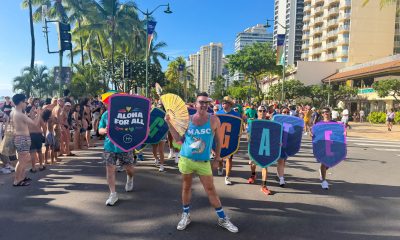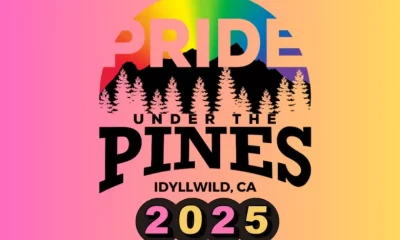Local
Generation Next
Emerging leaders generate inspiration
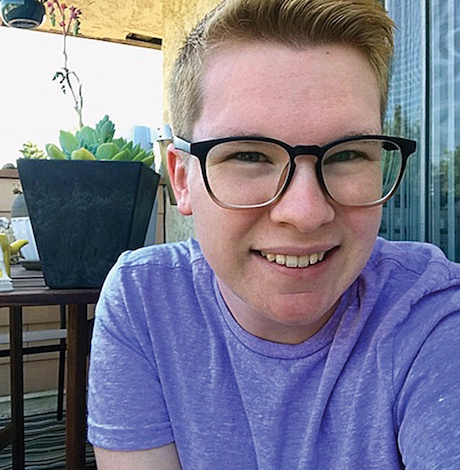
What is Pride? The most serviceable answer, of course, is that Pride is a commemorative event in which the LGBTQ community celebrates our triumph over adversity and the leaders who fought to make the world a more inclusive place. Historically, it was a political statement — a show of visibility and a forum for protest against homophobia.
And since the beginning of President Trump’s tenure, Pride feels political once more. This year’s celebration will pull from the civic engagement of the March for Our Lives and #Resist movements, spotlighting LGBTQ leaders while re-engaging in the community’s fight for social, legal, and political equality.
Much of that work did not begin, and it will likely not end, with the Trump administration. New research has found LGBTQ girls of color are disproportionately over-disciplined in schools, where they also face bullying and are ostracized. These challenges often push them out of the classroom and into the criminal justice system. And now that Betsy DeVos helms the U.S. Department of Education, prospects for many of our community’s most vulnerable youth are even grimmer.
At the same time, this year the country has witnessed the power of young people in bringing change. The young LGBT folks from the Los Angeles area profiled in these pages are speakers, students, advocates and artists. They have each made meaningful contributions in areas including climate change policy, battles against homophobia and transphobia, housing equality, and immigration.
As the LGBTQ community has witnessed and experienced a reversal in progress over the last two years, young leaders have offered hope for a better way forward. Another signal of the direction in which the arc of justice is headed: The decision by Boy Scouts of America to welcome girls into their ranks, and, effective next year, change the organization’s name to Scouts of BSA. Since the 1970s, women’s and LGBTQ advocates have lobbied the Scouts to adopt more inclusive policies. And in those battles, waged in and outside the courtroom, they have been ultimately victorious.
May these stories, challenges and history inspire you. Happy Pride.
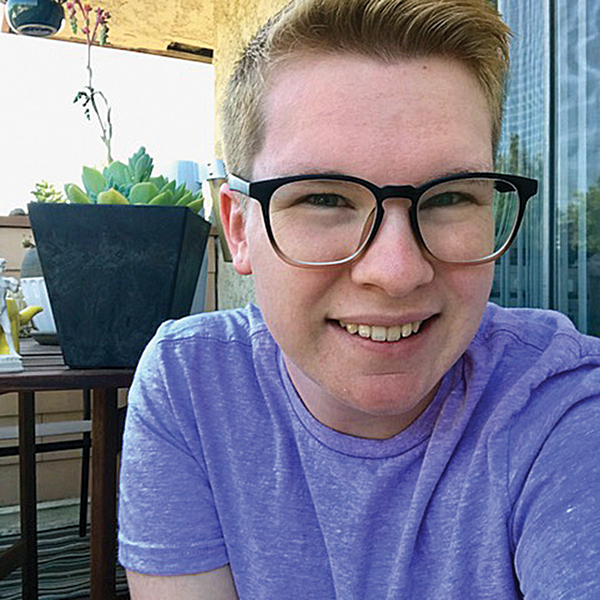
(Photo courtesy of Twitter)
Casey Hoke, 21, college student, LGBTQ advocate, artist
Casey Hoke is a fine artist, graphic designer, writer, activist, and advocate who was awarded a prestigious POINT Foundation scholarship to fund his education at California State Polytechnic Institute in Pomona, where he is now a junior pursuing a B.A. in Graphic/Communications Design with a minor in Art History. His past and present leadership appointments include a Student Media Ambassadorship for GLSEN, where he also holds membership with the National Executive Board.
Drawing from his experiences as a young trans man, Casey has spoken and written about subjects including education policies that concern transgender students, the representation of transgender people in the media, and the relationship between artistic self-expression and self-acceptance. His work has appeared in MTV News, Teenlife Media, and The Huffington Post, where he has blogged since 2014. Casey has delivered speeches at forums including a TEDx conference and Intel Labs’ LGBT Youth Leadership Forum.
Casey attended high school in Louisville, Kentucky. He came out as trans during his sophomore year. While fellow students, for the most part, were accepting of Casey, he explained the school’s Principal Gerald “Jerry” Mayes was a bully. In March, The Louisville Courier-Journal published a timeline of an ongoing investigation by Jefferson County Public Schools into Mayes’ conduct that was initiated in response to his treatment of trans youth, including Casey, as well as racially insensitive comments he made to two African-American students.
During his junior year, Casey was the subject of an article in the school’s newspaper that chronicled his journey and highlighted his advocacy work. In response, Casey explained, Mayes told members of the student newspaper staff that it was “wrong to profile a misfit going through a phase. He said it would be comparable to writing about someone who wanted to shoot up a school.” The following year, in 2015, as the state’s senate introduced a bill that would require transgender students to use restrooms that match the sex listed on their birth certificates, Casey said Mayes asked a security guard to monitor him in the men’s restroom. The principal then called Casey into his office and began asking invasive questions about his body and genitalia.
“It’s hard to talk about,” Casey said, “but I came out with my story because it needed to be heard, and because his treatment of LGBTQ students in my high school was, and still is, really bad.” Those experiences strengthened Casey’s resolve to advocate for the rights of trans students.
In college, Casey and his trans peers face a variety of administrative challenges. Changing one’s name on student ID cards is a difficult process. Freshmen, who are required to live on campus, must pay more for housing that offers single-stall restrooms (which are safest for transgender students)—a difference in cost that amounts to about $10,000. Administrators outed Casey to other staff and even students, despite his request that they keep information about his gender identity private. Casey has since led petitions that demand equal and affordable housing for trans students, as well as training programs on trans identity for university staff.
“My advocacy did not stop at high school, where I had this mean principal”, he said. “Even though I’ve seen trans folks accepted a bit more, publicly, there are still battles I have to face here in California.”
Casey’s interest in media representation of LGBTQ people and subjects overlaps with his interest in art. A project and educational resource that Casey created and curates, Queer Art History (housed online at queerarthistory.com) showcases a breadth of artwork, from a homoerotic 16th century Roman fresco to a poster produced by ACT UP Los Angeles in 1990. On the project’s website, Casey has written about the cultural and historical significance of each.
This project, he said, allows him to “talk about media representation while educating people of all ages on queer visual history, art, and culture.” Through another program, Art, Identity & YOU, which Casey created and administers in coordination with the Los Angeles LGBT Center, he provides a platform for youth education on identity, art, history, and self-expression.
Must modern queer art be political? Not necessarily, Casey said—it certainly can be, but queer art can also signify something as timeless as self-expression or look as visually diverse as abstract expressionism. Plus, the treatment of queer people as inherently political, Casey said, can be dehumanizing.
At a time in which major American cities have often become canvases for anti-Trump graffiti, contemporary queer art certainly feels political. And much of it borrows from the signage of protest art produced in the 1980s and 90s (A good example: Donald Moffett’s He Kills Me, a 1987 lithograph that features a grid of President Ronald Reagan’s grinning headshot with “THIS GUY KILLS ME.” in bright orange type across his chest.)
Through the POINT Foundation, Casey was connected with a mentor who works for the Walt Disney Company, where he aims to secure a design position post-college. He is optimistic about both his future and the direction in which society is headed, despite the anti-LGBTQ policies of the Trump Administration. “I asked Mara Keisling, executive director of the National Center for Transgender Equality, how things are looking for young trans and non-binary folks”, Casey said. Reflecting on the progress that’s been made so far, Keisling responded: “You know what? We’ve gotten here.”
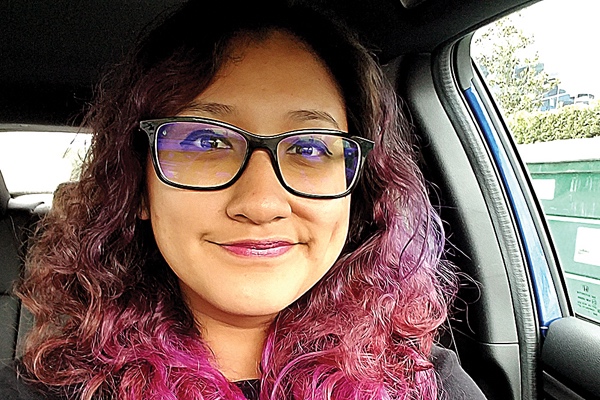
(Photo courtesy of Nunez)
Priscila ‘Pea’ Alegria Nunez, 23, documentarian and cinematographer
“The stories that I’m passionate about sharing and telling are about the Latinx community and LGBTQ community. It’s very important for me to highlight our voices, as immigrants who are fighting back.”
Pea is a documentary filmmaker, an artist whose work reflects their lived experiences as a pansexual non-binary immigrant who, at 15, left Peru with their mother for the professional and educational opportunities available in the United States.
A recent graduate of the acclaimed film program at the University of California, Los Angeles (UCLA), this year Pea was awarded a Rising Star Grant from GLAAD to fund their virtual reality (VR) project about the networks that immigrants have built to support and defend their communities. The film is led by a lesbian protagonist who left Honduras for the United States.
“Throughout the US, immigrant families they have this traumatizing event in which they are visited by [Immigrations and Customs Enforcement (ICE)]”, Pea explained. “Our protagonist is going to college, and she’s using her knowledge and her network to bring an emergency community back to her house. We will see how that event develops because of how many people will show up to help fight back.”
As an immigrant who belongs to the LGBTQ community, Pea is inspired most by the stories of people who occupy both of those identities. “I found that the projects that bring me the most fulfillment are those that find that intersection.”
Pea and their mother had green cards when they left Peru. They landed in Sacramento, where Pea says their high school was nationally recognized for the racial and ethnic diversity of its student body. “It was incredible to be surrounded by so many brown people—by so many inspiring, motivational people.”
At UCLA, Pea’s classes in gender studies opened their eyes to the identities that do not fall into the gender binary, which gave them the space to inhabit gender-neutrality, along with the freedom to dress and use pronouns in non-traditional ways. “It was another coming out for me. I’d already come out as bisexual, but then again as pansexual.” (The latter is defined by the absence of limits with regard to sexual choice in gender or activity.) Coming out to their mother—who understands Pea is attracted to both men and women—as non-binary, Pea said, is something of a work-in-progress, an ongoing journey.
Respective to both their personal life and professional work, Pea focused first on their immigrant identity and the stories of other immigrants more broadly before working to explore how sexual orientation and gender identity come into play.
Night of Cultura, a Latinx club of artists at UCLA, was a forum in which Pea found some of their closest friends and most valuable professional networks. The group creates plays, sketches, spoken word poetry, dances, and films—works that often include LGBTQ subject matter. “It was a space where I really felt like I blossomed.” After screening a 5-minute documentary at a Night of Cultura event, Pea met a UCLA alum in the audience who would later become the screenwriter for their VR project.
As a filmmaker, Pea is moved by the audience’s reaction to their work. “You can hear gasps; you can hear sniffles; you can hear laughter. I think that’s so beautiful because you wonder what’s going on in their hearts. There is a chance of really reaching people. There is hope that your project, that your work, will touch people.”
On the challenges brought forth by attacks on LGBTQ and immigrant communities from the Trump administration, Pea is optimistic about the role of the artist. “It’s important that we creators continue making work, regardless of the political climate. It’s important to keep creating, because who is going to do it, if not us?” Immigrants and LGBTQ folks should tell their own stories, Pea said, because that way the diversity within those communities will be reflected in the broader cultural narrative.
In hindsight, Pea feels they should have explored and expressed their sexual orientation and gender identity earlier in life. “I felt like I needed to be compliant to what my mom wanted—to her expectations. I could have been so much happier, if I had not waited and instead just been myself.” Pea’s message to LGBTQ teenagers: “Come out to your friends first, because there is something to be said for finding your family outside the family you grew up with. Find yourself a queer family. When you do, you’ll be amazed how powerful you’ll be.”
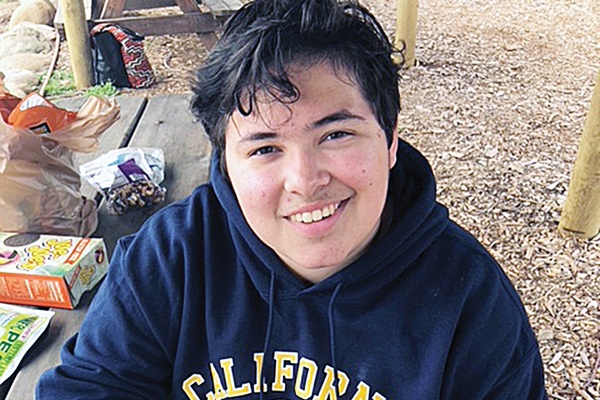
(Photo courtesy of Reyes)
Aris Reyes, 16, high school student, LGBTQ advocate
Aris is a 16-year-old high school student who aspires to a career in politics, business, law, or, perhaps all three.
Though only a junior, Aris has emerged as a leader at USC East College Prep, a new high school of which his will be the first graduating class. He founded both the student government and the GSA club, where he now serves as president.
As a young trans Latino man and LGBTQ advocate, Aris has built bridges between his school’s students and staff, as well as between his peers and organizations dedicated to LGBTQ youth education and empowerment.
He helped to spearhead the LGBTQ School Climate Resolution, a comprehensive survey that collects information about a school’s educational atmosphere respective to LGBTQ issues. Aris was not entirely surprised to learn 80 percent of his classmates had either often or occasionally heard homophobic remarks from other students. On the other hand, only 10 percent of student respondents heard their teachers say something objectionable about LGBTQ people, which is consistent with Aris’s perception that educators at his school are more liberal and tolerant.
With data from the survey, Aris approached his teachers about ways they could help improve the school’s record on LGBTQ issues. He cited California’s FAIR Education Act, which, among other requirements, obligates teachers to include LGBTQ historical figures in their lesson plans. The law applies only to the state’s public schools, so teachers who work at Aris’s charter school are free to create their own lesson plans—and there, he said, there is room for substantial improvement.
Aris worked with the Latino Equality Alliance’s (LEA) youth council to coordinate a speaking engagement at his school that featured a representative from the ONE Archives of the University of Southern California (USC). “They talked about LGBT leaders and advocates”, he said, “including some people I’ve never heard of in my life.”
The organization administered 10 workshops throughout the year, including the Unconditional Love Rally, where Aris spoke about transphobia and his personal journey toward self-acceptance. The program required registrants to get prior approval from their parents, but Aris worked with school administrators who agreed to count the rally toward community service hours—which helped to bolster attendance.
Aris opened up to his mother about his gender identity in eighth grade and the following year came out to friends, teachers, and classmates. Like many transgender youth, Aris struggled with body image issues and depression. Not yet out to his father and living in a body that did not reflect his gender identity, while a freshman Aris was placed in a three-day psychiatric hold. There, he was isolated away from other patients—and told by nurses he could not be placed in units segregated by gender because he is neither male nor female. This, in spite of the fact that Aris explained he is a transgender man.
Back at school, Aris is sometimes asked probing questions by other students concerning his anatomy. “My school is in Lincoln Heights in Los Angeles”, he explained, “and Hispanic culture is not always that accepting of LGBTQ people.” Teachers, by contrast, have been more welcoming—he only needs to remind them, occasionally, to not mis-gender him.
Administratively, Aris has met challenges such as the attendance roster and the separation of girls and boys in advisory periods. “It can be isolating”, he said.
Involvement in advocacy programs and social clubs has allowed Aris to build a sense of community and work on behalf of issues that are important to him. “Even within the LGBT community”, he said, “I feel like trans people are left out a lot.” The separation of gender and sexuality in the discussion of LGBTQ issues, as well as the ways in which we introduce these topics to young people, is important to Aris. The conflation of sexual orientation and gender identity, he said, can cause misunderstanding.
Aris also hopes the Hispanic/Latino communities will begin to adopt more progressive attitudes toward LGBTQ people. He feels less tolerant attitudes exist primarily among older generations. “Friends have told me”, he explained “‘My mom doesn’t like you because you’re trans.’ It’s just sad—just because of that, like, [they don’t care] about everything else I do, what a good kid I am, my grades or my education.”
Homophobia and transphobia will always exist, Aris said, and “people are scared of things they don’t now”. Looking to the future, he is more interested in effecting change through policy. “For me, really what matters is the legislation—that’s what changes everything. If you’re a lawyer or a president or lobbyist, you’re in a position to change things.”
Aris expects to continue working on behalf of LGBTQ causes. “After I graduate”, he said, “I hope to go to college. I want to get really involved in my college.”
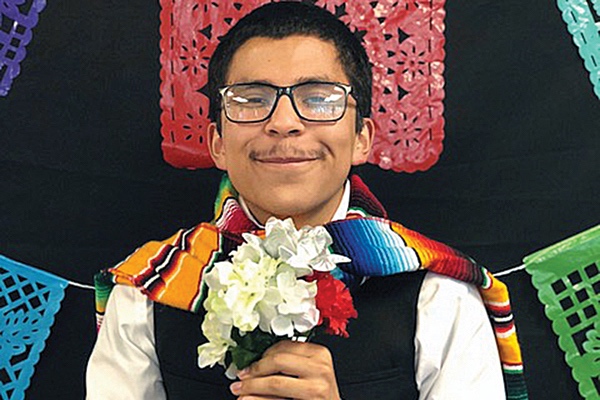
(Photo courtesy of Medina)
Alex Medina, 18, student journalist, LGBTQ advocate
Alex Medina is a student journalist who has authored more than 20 articles for his local newspaper, the Boyle Heights Beat, which covers news and feature stories in and around the downtown Los Angeles neighborhood.
He will soon graduate from high school and is eager to begin his freshman year at Hamilton College, a selective liberal arts university in update Clinton, New York. Then, Alex hopes to work toward a career in journalism. And he also has designs to start an organization dedicated to youth and the media.
Much of Alex’s work for Boyle Heights Beat is focused on LGBTQ issues, which he considers especially important because, particularly in decades past, LGBTQ people are often portrayed negatively. He said that spotlighting the work of advocates and activists helps to usher in progressive change while also offering role models for young people. Additionally, Alex has written about subjects important to immigrant communities—such as the census and the Free Application for Federal Student Aid (FAFSA)—as well as local politics and business.
For two years, Alex has served as president of his school’s GSA club, where he led efforts to curb the use of derogatory language and anti-LGBTQ slurs. In conversations with the student body, Alex and members of the club worked to encourage their peers to be more conscious of the language they use. “I used to get bullied when I was younger. So, it’s important to me that we have these conversations”, he explained, especially for the benefit of young LGBTQ folks.
Beyond the GSA, Alex works on behalf of a variety of causes that reflect the diversity of the subjects he has written about. Through his involvement with the Latino Equality Alliance (LEA), for example, Alex has advocated for policies that would help to curb the school-to-prison pipeline.
Alex credits many of his accomplishments to the unwavering support he’s received at home. His parents, who immigrated to Los Angeles from Mexico, have been involved with organizations like PFLAG—where they engage with other parents, many of them Latino, to facilitate conversations about accepting their children’s sexual orientation and gender identity.
It can be challenging work, he said. LGBTQ identities are often not discussed within Latino communities. “Youth often don’t come out to their parents because they’re afraid how their parents will react,” he explained. “When Latino people [immigrate to the US], there are prejudices—often formed by the things they heard when they were growing up—and they often bring that with them. It’s also generational.”
While young people have overwhelmingly adopted more positive positions on LGBTQ issues, change can also be witnessed in traditionally-conservative milieu, such as the Catholic Church. Just a few weeks ago, Pope Francis told a gay man, “God made you like that.” Alex agreed about the direction in which organized religion seems to be heading, at least concerning Catholicism. “With the Pope being more accepting,” he said, “it’s getting better. At my own church and at the other church I’m involved with, they’re accepting of me and the pastors communicate very positively about it.”
The role played by organizations, like PFLAG, that offer programs and resources for LGBTQ youth and allies is really important, Alex said. “In schools there often isn’t much awareness, even if there is acceptance, so these organizations help to fill in and offer resources—including condoms, and healthcare referrals—that are not available in school. There are a lot of events and opportunities available through those organizations that students wouldn’t otherwise know about. It’s important for parental acceptance as well.”
Alex feels the tremendous progress the LGBTQ community has witnessed over the years would not be possible if advocates and activists were not optimistic about their odds. “We wouldn’t have the movement we have today without people who brought awareness about things like AIDS, DOMA, and [same-sex] marriage”, he said. Beyond the fight for political equality, Alex feels adopting a positive attitude is important for building friendship and community.
Another corollary goal of Alex’s: Increasing the visibility of young people who are working to effect change. “A lot of times”, he said, “youth don’t see themselves represented. It’s important to bring attention to the work young people are doing to build a better future for themselves and for future generations of youth”.
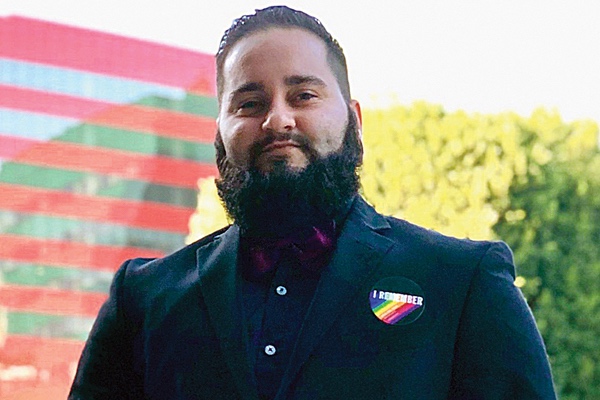
(Photo courtesy of Akbarian)
Rudy Akbarian, 28, trans-Armenian veteran, aspiring barber
Rudy Akbarian is a transgender man, the son of Armenian immigrants, and a veteran who served in the U.S. Army from 2011 to 2016. He has also worked on behalf of LGBTQ youth, specifically homeless youth, and next month will begin studying to become a barber.
Before today, Rudy has spoken out twice about policies concerning the inclusion of openly-trans men and women in the military. In 2016, he praised the historic decision by former Defense Secretary Ashton Carter to welcome transgender people into the armed forces. Then, last year, he denounced President Trump’s reversal of that policy but pledged to keep up the fight: “I’ve had too many people supporting me to just give up,” he said. “So, I don’t plan on doing that.”
Today, Rudy responded to reports from Tuesday that 100 members of Congress have submitted a letter to Defense Secretary James Mattis, urging him to reconsider the Administration’s decision to bar openly trans men and women from military service.
“That’s awesome,” he said. “But I don’t know what [Trump’s] reasoning was for not allowing trans people to serve in the military, other than ‘It would cost a lot of money.’” And this, Rudy pointed out, despite the President’s request for a military parade that The New York Times reported could total $30 million (at a time in which those funds could be better allocated to address homelessness among America’s veterans).
Importantly, Rudy added, the projected medical costs associated with treating the estimated 15,000 trans men and women in the armed services—which, according to a RAND study, would add up to $8 million—are likely even less. “Not every trans person wants to surgically or medically transition,” he explained. “That’s a stereotype we need to break.”
Rudy’s position on the capabilities of trans soldiers?
“After I conquered that battle to become my authentic self—and I did it alone—now, God only knows how many other battles and wars I can win with a team. Trans people are some of the strongest people and some of the most mentally capable people to protect and serve this country.”
Rudy said most of the transphobia he has encountered so far has been in civilian life. The men and women who served alongside him were focused on the demands of the mission before them, and close bonds were born from shared experiences and the close quarters in which they worked and lived.
Restroom and shower accommodations, particularly while Rudy was in the process of transitioning, proved challenging. Without an official gender marker that matched his gender identity he was not allowed to access the men’s facilities. Once, during a five-day range training excursion in the desert, Rudy had to use the women’s showers. And by this time, he had grown a full beard. “It was a super traumatizing experience for me, as well as for them. Because, they’re like, ‘Why is there a guy in the shower?’”
However difficult it was, as a trans man, to navigate the administrative hurdles of military life, Rudy had already weathered a lot of heartache. He came out first as a lesbian and was consequently kicked out of his home. “It was a really hard time in my life,” Rudy said. Like many young people in his position, he abused drugs and alcohol to cope. For more than six years now, Rudy has been sober—and his family eventually reconciled with him.
At first, he explained, the subject of his sexual orientation was off the table, but then Rudy journeyed closer to accepting his gender identity. “It was undeniable when the hormones kicked in,” he explained. “Then, I gave my family the choice to be there for my top surgery, and they showed up.” Rudy said they are now 120 percent supportive.
“One time, I discovered that my mom, who has this heavy Armenian accent and types the way she talks, was responding to these negative comments about me on social media. [Imitating her accent] ‘That’s my son and I love him and he’s very handsome!’ She was totally there in support, doing all of this emotional labor. It was so incredible to see that.”
These days, Rudy is incredulous about the policies introduced and supported by the President, especially those concerning transgender men and women in the armed forces. At the same time, he has witnessed tremendous progress in both his family and community—especially among young people—which, he said, signals movement in the direction of justice and equality.
Through social media, Rudy has comforted other LGBTQ folks, including Armenians who are struggling with coming out to their families. It’s just another form of advocacy, he said—a way to build and strengthen community.
Recently, Rudy was invited, by his former art teacher, to speak before a high school group called Students Advocating Gender Equality (SAGE). “When I was [a student] there,” he said, “there were three students in GSA, and I was one of them. At this event, I was talking to, like, 50 kids. They were all embracing and accepting each other—and it’s students in high school who are creating these clubs and programs.”
Los Angeles
LGBTQ+ community calls out Radio Korea over host’s homophobic comments; station acknowledges but skirts accountability
On Nov. 3rd, Radio Korea host Julie An claimed that “gay people began the spread of AIDS” on a talk show broadcast by the station.
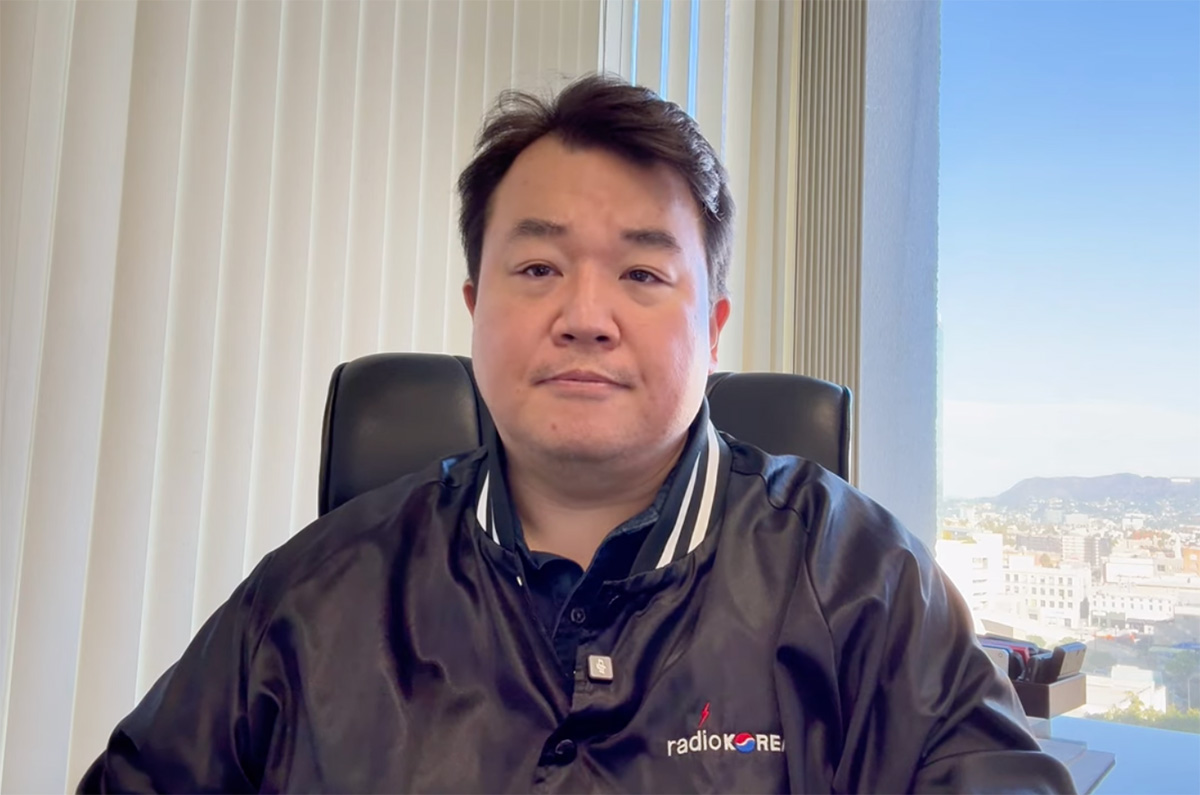
On Monday, Nov. 3rd, Radio Korea aired its regular morning talk show program, where one of its hosts, Julie An, discussed her lack of support for the LGBTQ+ community, citing her religious beliefs. She also went on to comment that gay people spread HIV and AIDS, and that conversation therapy — which has been linked to PTSD, suicidality, and depression — is a viable practice. Clips of this have since been taken down.
Radio Korea offers Korean language programming to engage local Korean American and Korean immigrant community members. Its reach is broad, as Los Angeles is home to the largest Korean population in the U.S, with over 300,000 residents. As An’s words echoed through the station’s airwaves, queer Korean community members took to social media to voice their concern, hurt, and anger.
In a now-deleted Instagram post, attorney, activist, and former congressional candidate David Yung Ho Kim demanded accountability from the station. Writer and entertainer Nathan Ramos-Park made videos calling out Radio Korea and An, stating that her comments “embolden” people with misinformation, which has the ability to perpetuate “violence against queer people.”
Community health professional Gavin Kwon also worries about how comments like An’s increase stigma within the Korean immigrant community, which could lead to increased discrimination against queer people and their willingness to seek health care.
Kwon, who works at a local clinic in Koreatown, told the Blade that comments like An’s prescribe being gay or queer as a “moral failure,” and that this commonly-held belief within the Korean immigrant community, particularly in older generations, strengthens the reticence and avoidance clients hold onto when asked about their gender or sexual orientation.
“When you stigmatize a group, people don’t avoid the disease — they avoid care,” Kwon explained. “They avoid getting tested, avoid disclosing their status, and avoid talking openly with providers. Stigma pushes people into silence, and silence is the worst possible environment for managing any infectious disease.”
For weeks, Radio Korea did not offer a direct response to the public criticism. Its Instagram feed continued to be updated with shorts, featuring clips of its various hosts — including An.
On Friday, Radio Korea CEO Michael Kim released an official statement on the station’s YouTube page. In this video, Kim stated that An’s comments “included factual inaccuracies” and that the station “does not endorse or share the personal opinions expressed by individual hosts.” Kim also stated that Radio Korea “welcomes members of the LGBT community to share their perspectives” in order to deepen understanding through dialogue.
Afterwards, Kim continued that though he acknowledges the “pain” felt by queer community members, he concluded: “I don’t think Radio Korea needs to apologize for what was said any more than Netflix should apologize for what Dave Chappelle says, or any more than Instagram or TikTok should apologize for what people say on their platforms.”
Kim then offered a justification that An’s statements were “not part of a news report,” and that he was “disappointed” that David Yung Ho Kim, specifically, had been vocal about An’s comments. Kim stated that he was the first person to interview David in 2020 during his congressional campaign, and that he had provided the candidate a platform and opportunity to educate listeners about politics.
“After all these years, the support Radio Korea has given him,” said Kim, “the support I personally gave him, even the support from other Radio Korea members who donated or even volunteered for him — he dishonestly tried to portray Radio Korea as being an anti-gay organization.”
Kim went on to criticize David’s purported “hurry to condemn others,” and also questioned if David has disowned his father, who he states is a pastor. “What kind of person is David Kim, and is this the kind of person we want in Congress?” Kim asked viewers, noting that Koreatown is “only about three miles from Hollywood, and some people just like to perform.”
At the end of the video, Kim stated that his duty is to guard the legacy of the station. “My responsibility is to protect what was built before me and ensure that Radio Korea continues serving this community long after today’s momentary controversies disappear,” Kim said.
For community members and advocates, this response was unsatisfactory. “The overall tone of the statement felt more defensive than accountable,” Kwon wrote to the Blade. “Instead of a sincere apology to the LGBTQ+ community that was harmed, the message shifts into personal grievances, political dynamics, and side explanations that don’t belong in an official response.”
Kim’s portrayal of the criticism and calls to action by community members as a “momentary controversy” paints a clearer picture of the station’s stance — that the hurt felt and expressed by its queer community members is something that will simply pass until it is forgotten. An continues to be platformed at Radio Korea, and was posted on the station’s social media channels as recently as yesterday. The station has not outlined any other action since Kim’s statement.
Los Angeles
Forgetting queer pioneer Morris Kight is “impossible”: Advocates and friends share stories at remembrance
On Saturday, Nov. 22nd, Kight’s ashes were interred at Hollywood Forever Cemetery.
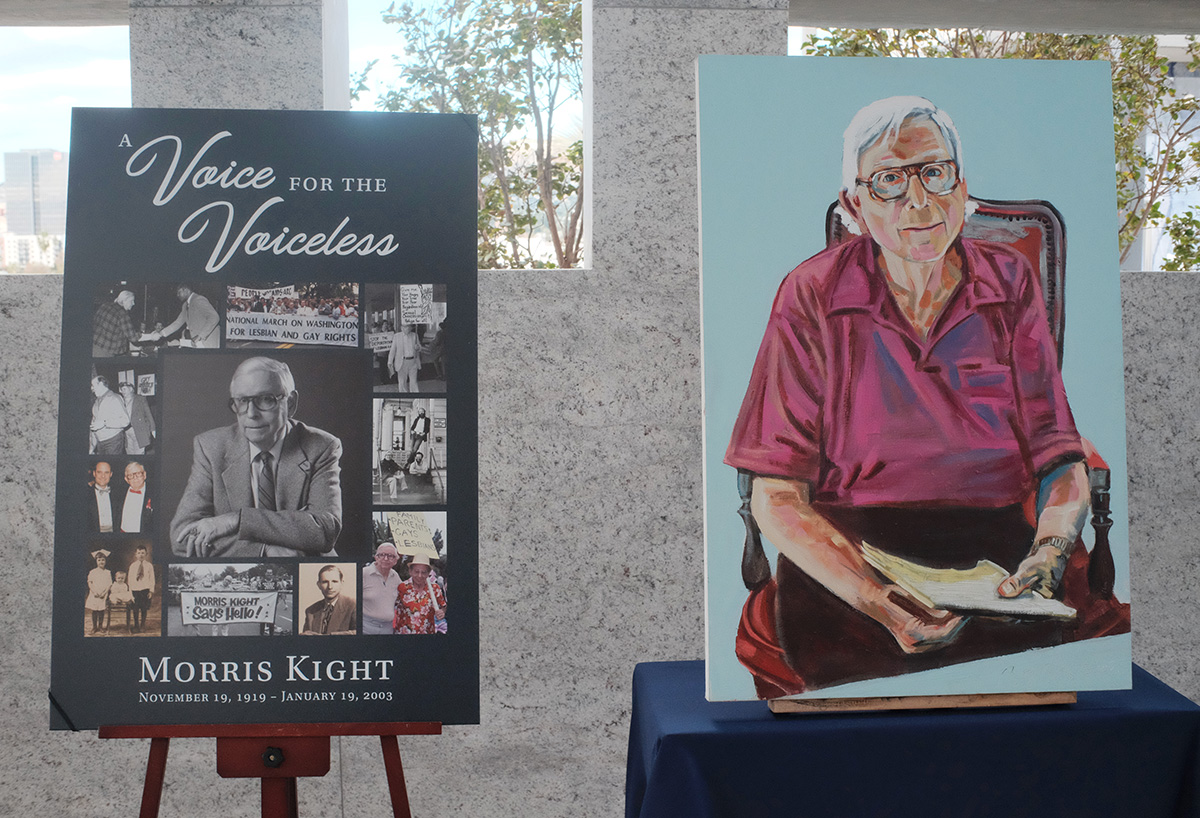
Over 50 people made their way to the rooftop chapel at Hollywood Forever Cemetery’s Gower Mausoleum on Saturday afternoon, taking in sweeping views of the city as a gentle wind began to envelop the space — a wind that some thought signaled the presence of Morris Kight. Hosted by local nonprofit AIDS Healthcare Foundation (AHF), this reception provided longtime friends, fellow activists, and anyone else impacted by Kight’s legacy with the opportunity to share some of their most memorable stories about the LGBTQ+ vanguard.
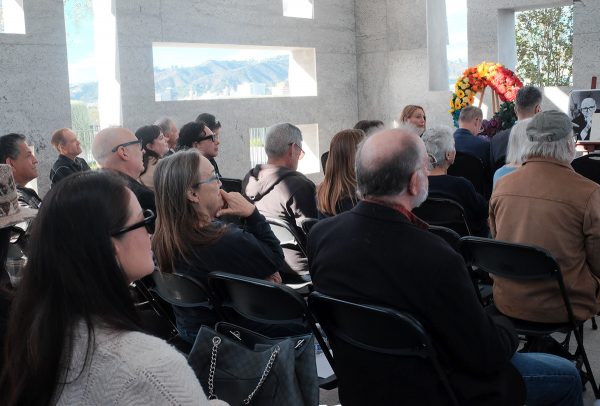
Kight died on January 19, 2003, after decades of leading peaceful, bold, and outspoken action against oppressive systems that targeted marginalized communities. As Congresswoman Maxine Waters declared at the remembrance event: “You have to be a hell of somebody to be memorialized 22 years after.”
Kight co-founded the Los Angeles LGBT Center in 1969, first known as the Gay Community Services Center, where so many queer youth and adults found the courage and empowerment to seek education, resources, and comfort. It became the place where they could fully embrace themselves.
At 19, AHF president Michael Weinstein found himself at the front steps of the Center, afraid but compelled. This is where his and Kight’s lives would intertwine, setting him on his own path of liberatory leadership. This first encounter and relationship “cemented” his identity, Weinstein told the crowd, after an arduous search for belonging and internal understanding.
The impact Kight had on Weinstein and innumerable other queer folks was not just a consequence of his work, but the purpose for it all. “We were his payment. We were his reward,” said Miki Jackson, Kight’s longtime friend and another instrumental voice in early LGBTQ+ movements. “Morris cared that we were loud enough, we were out enough, we were visible enough that a child in Kansas in elementary school would know about it. He cared about where people were wounded the most.”
Kight projected his voice in hopes it would reach those who were silenced, becoming the face of several important movements, including the Gay Liberation Front. He raised money for people with AIDS, co-founded the Stonewall Democratic Club, and pushed for L.A.’s first pride parade in 1970 — unabashedly fighting for the visibility of LGBTQ+ people as they were met with societal violence and rejection.
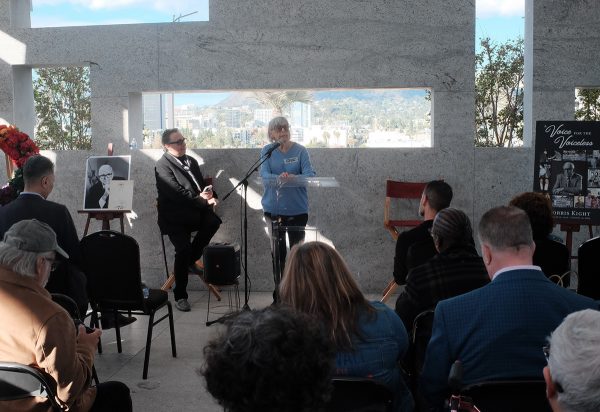
“The idea of forgetting a Morris Kight is basically impossible,” said Terry DeCrescenzo, one of the founders of the Gay Academic Union. She recounted fond memories with Kight, including a story tied with her roots of protesting. Together, they blocked the streets of Sunset and Larrabee and sang the civil rights anthem “We shall overcome.” At first, DeCrescenzo was in disbelief. “I thought, ‘I went to Catholic school for 17 years to sit on the sidewalk singing We shall overcome?’ And the answer is yes. He showed me a way of doing things — of approaching life — that I didn’t dream I was capable of. So I thank you, Morris. I love you. I miss you.”
Kight’s ashes have been officially interred at Hollywood Forever Cemetery, granting him a final resting place. In life, he built sites of belonging for queer people, and today, this ground joins a tender catalog of spaces that contains a trace of what his loved ones hope he is remembered for: the fierce kindness with which he led his life. His endless stories. His desire to be with and fight for the people he loved.
Saturday’s remembrance event also offered a moment of deep reflection for the future of local queer activism. “We’re what we have left,” said Jackson, a queer elder who marched alongside Kight in the country’s early days of LGBTQ+ protesting — and who paved a path for younger advocates like Congressman and Equality Caucus Chair Mark Takano to continue the fight. “May we honor Morris by carrying his fire forward until every LGBTQ+ person in this country can live safely, open and unafraid,” said Takano.
Los Angeles
The Los Angeles LGBT Center has reopened and upgraded its community tech hub
The David Bohnett CyberCenter provides free access to important tech resources for LGBTQ+ community members.
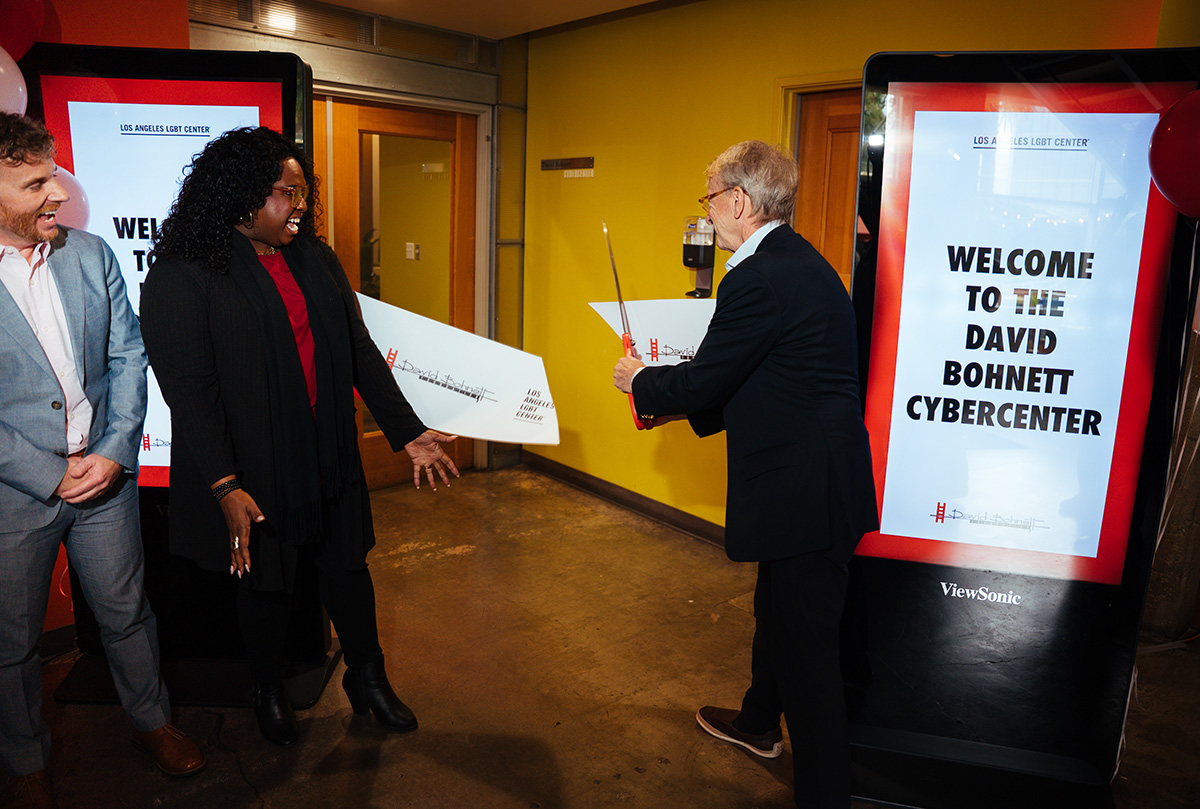
On Thursday, community leaders and advocates gathered at the Los Angeles LGBT Center for a joyous ribbon-cutting event that ushered in the organization’s revamped tech hub. For 27 years, the organization’s David Bohnett CyberCenter has provided local residents a safe space to utilize computers, printers, scanners, and attend workshop opportunities to build their tech literacy skills, stay connected, discover joy, and research important opportunities.
Here, individuals can safely surf the web, complete online benefits and services forms, apply for jobs, as well as make progress towards educational programs. It’s a safe space where LGBTQ+ community members can reliably use technology that can provide them with vital avenues into improving and living their lives.
The CyberCenter is funded by the David Bohnett Foundation, which provides grants to various LGBTQ+ initiatives and social programs nationally in order to improve equity for different marginalized communities. In 1998, the foundation established its first tech hub at the Los Angeles LGBT Center, so that queer community members would not be shut away as technological advancements made online access increasingly necessary. “The idea was simple but urgent,” Bohnett said at yesterday’s ceremony. “[It was meant] to ensure that LGBTQ+ people had access to the technology that could open doors to education, employment, and connection.”
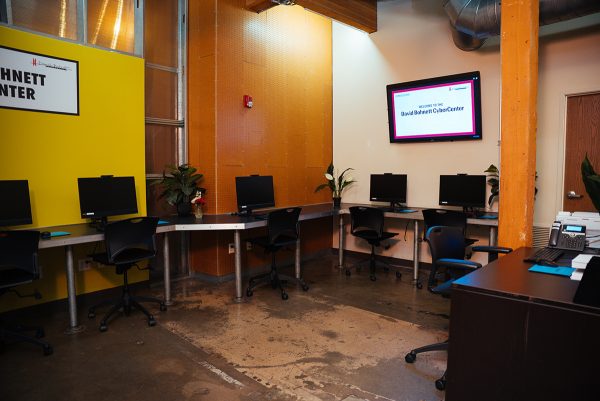
Yesterday, this CyberCenter’s updated facilities were welcomed with warm applause, cheer, and a celebratory banner that was cut by Bohnett himself. It marked an evolving growth towards the foundation and the Center’s shared commitment to the hub’s initial promise: to guarantee equitable technological access to the county’s queer residents.
“Our community members regularly share how missing even one piece of access—a computer, a quiet place to work, a stable connection—can stall their progress,” said Sydney Rogers, senior program manager at the Trans Wellness Center. “For so many, technology isn’t just a tool—it’s the gateway to opportunity. Résumés, job searches, online trainings, interview prep—all of it depends on having access to reliable equipment and an environment where people feel safe and supported.”
For Bohnett, what began as a room with a “handful of computers” has grown into over 60 CyberCenters nationwide — and they are all “rooted in the belief that digital access is not a luxury, but a lifeline,” said Bohnett. “Every time I’m back here, I’m reminded that the Los Angeles LGBT Center was the first to bring that vision to life.”
The David Bohnett CyberCenter is open from Tuesdays to Thursdays, from 10 a.m. to 1 p.m., and from 2-5 p.m. More information about its location and services can be found here.
West Hollywood
From nickname to reality, the Rainbow District is made official by the City of West Hollywood
The mile along Santa Monica Boulevard from N. Doheny Drive to N. La Cienega Boulevard welcomes residents and visitors to come as they are
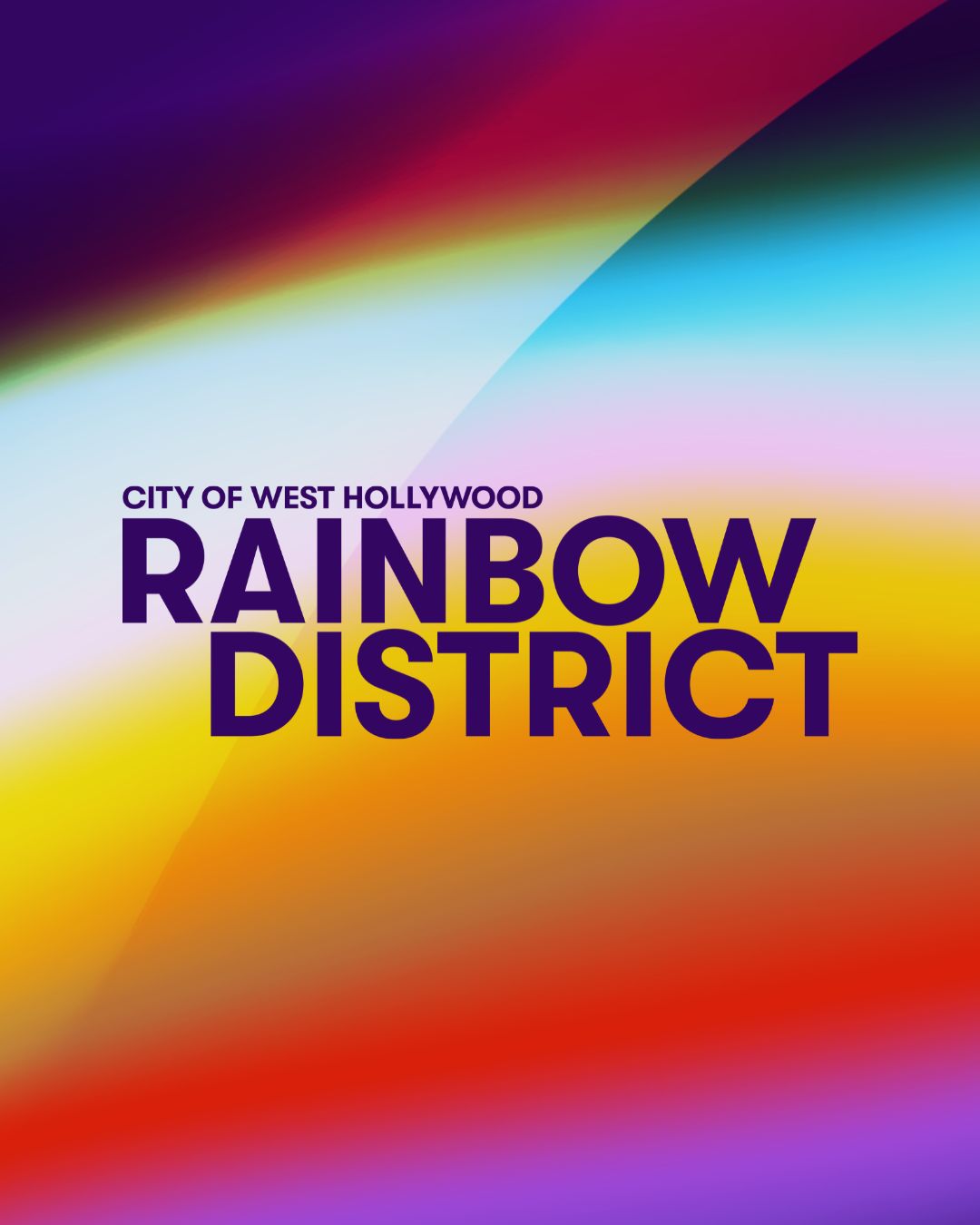
Even in today’s political climate, we will not be hidden.
The vibrant stretch on Santa Monica Blvd of over 50 local businesses, representing the full spectrum of LGBTQ+ expression, from N Doheny Dr to N La Cienega, has had the loving nickname of the Rainbow District for decades. Well, now it’s official. From nightlife to restaurants to community organizations, the City of West Hollywood has formally designated the space as such, honoring the neighborhood’s legacy as a safe haven for the queer community and beyond.
In addition to making the name official, the Rainbow District is being launched with a full range of social media, including Instagram, TikTok, and Facebook, keeping the residents and visitors updated on all upcoming events and happenings in the neighborhood.
Long known as a beacon of acceptance, inclusion, and visibility, where everyone is welcome, this iconic mile-long corridor is now formally recognized for what it has always been: a place where people from every walk of life can come together, be themselves, and celebrate the beauty of diversity.
City of West Hollywood Mayor Chelsea Lee Byers states, “For generations, the City of West Hollywood’s Rainbow District has been a place where LGBTQ+ people take their first steps into living openly, where the warm embrace of community is found at every turn, and where the joy of living out, loud, and proud fills the streets. The City’s official designation of the Rainbow District honors both the legacy and the future of this vibrant neighborhood, home to beloved entertainment venues, bars, and restaurants that have long served as cornerstones of LGBTQ+ life. Today, the Rainbow District is more alive than ever, and it will always stand as a beacon of hope, pride, and belonging and as a reminder that everyone deserves a place to celebrate joy, to be seen, and to be supported.”
The Rainbow District officially joins a nationwide list of iconic LGBTQ+ landmarks. West Hollywood will not be hidden amid political backlash and will continue to protect queer spaces, uplift queer voices, and foster a safe and joyful environment for all.
“This designation is not only a celebration, but it also serves as a promise,” said Visit West Hollywood President & CEO Tom Kiely. “A promise to keep LGBTQ+ spaces visible, valued, and vibrant for generations to come. As the Rainbow District continues to evolve, it will remain a place where locals and visitors alike can connect through culture, creativity, and community. The City’s formal designation affirms its significance and highlights The Rainbow District as the ultimate playground for travelers seeking a unique, inclusive, and authentic experience.”
The Rainbow District will be home to upcoming community events that include:
- Winter Market & Ice Skating Rink — December 2025
- Go-Go Dancer Appreciation Day — March 2026
- Harvey Milk Day — May 22, 2026
- WeHo Pride Weekend & the OUTLOUD Music Festival at WeHo Pride — June 5–7, 2026
Follow the Rainbow District on socials to discover local happenings, support small businesses, and be part of a neighborhood that celebrates every person for exactly who they are.
Instagram: @RainbowDistrictWeHo TikTok: @RainbowDistrictWeHo
Facebook: facebook.com/rainbowdistrictweho More Info: visitwesthollywood.com/rainbowdistrict
West Hollywood
West Hollywood’s AIDS Monument preserves the pain and power of people lost to the crisis
STORIES: The AIDS Monument is now available to view at West Hollywood Park, 15 years after its conception.
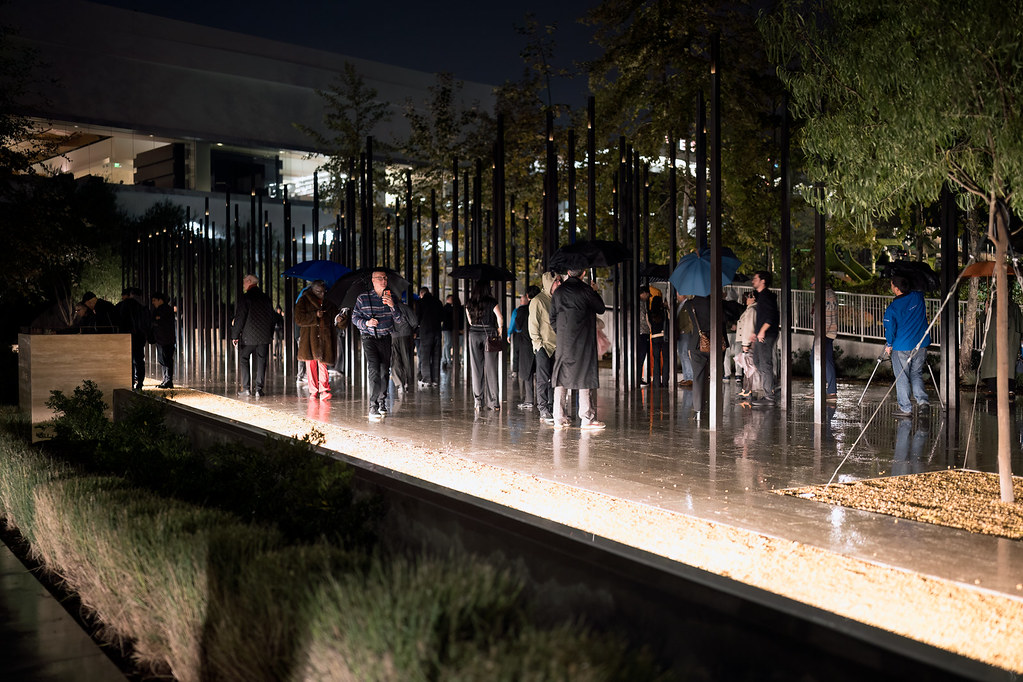
It was 1985, at the height of the AIDS crisis, when Irwin Rappaport came out as gay. As he came to terms with his identity, he witnessed people around him grow weaker: their faces becoming gaunt, painful lesions developing on their bodies. Five years later, he began volunteering as a young lawyer at the Whitman-Walker Clinic, a community health hotspot in Washington, D.C. that created the first AIDS hotline in the city, opened homes for patients with AIDS, and distributed materials that promoted safe sex.
The work being done at the clinic was instrumental, essential, and deeply painful. “When you see that sickness and experience that death among your friends and people you know, and when you’re writing wills for people who are much too young in ordinary times — it has an impact,” Rappaport told the Blade. “And even though in 1996 we saw life-saving medications come around, you never forget the sense of fear that permeates your life. The sense of loss.”
Determined to honor and share the legacies of people who died from AIDS, Rappaport joined the Foundation for the AIDS Monument (FAM) board to work towards the organization’s goal of creating a physical monument dedicated to memorializing these histories. FAM treasurer Craig Dougherty first conceived of this project in 2010 and, after 15 years, STORIES: The AIDS Monument is now available to the public for viewing.
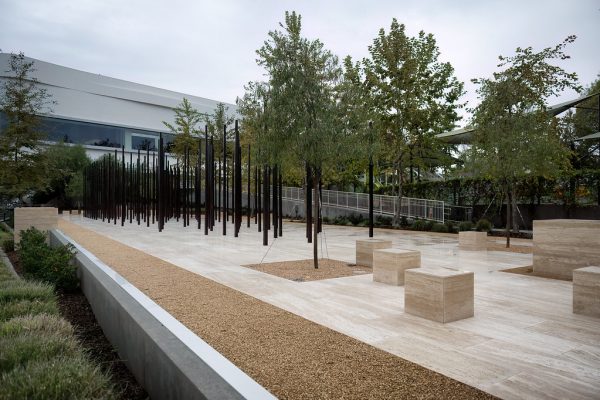
Created in collaboration with the City of West Hollywood, STORIES: The AIDS Monument is composed of 147 vertical bronze pillars known as “traces.” Designed by artist Daniel Tobin, 30 of these traces are engraved with words like: activism, isolation, compassion, and loss, which correlate to the over 125 audio stories collected and archived on the foundation’s website. This multimodal storytelling allows people who come across the monument to engage more intimately with the people represented by these physical pillars.
At nighttime, lights transform the monument into a candlelight vigil, providing a warm glow to a wanderer’s journey through the structure.
When people were able to walk around the traces at Sunday’s grand opening ceremony at the Pacific Design Center, the last remnants of the weekend’s rainstorm created a kind of “spiritual” and reverent atmosphere for those gathering, according to Rappaport. “I think there’s a certain peacefulness and serenity about the design, an opportunity for reflection,” he continued. “For some, it may bring back incredibly painful memories. It might bring back wonderful times with friends who are no longer here. It might remind them of their own caregiving or activism, or the sense of community that they felt in striving with others to get more attention to the disease.”
Now that the monument has been built, FAM has passed the mantle of management and programming to One Institute, a nonprofit that engages community members with queer history through panels, screenings, and other educational initiatives. One Institute plans to host monthly docent tours, art installations, and other special events during various LGBTQ+ national awareness days, including the upcoming World AIDS Day in December.
Rappaport also hopes to do outreach with local schools, so that young students are able to engage with the monument, learn about the people who were affected by the AIDS crisis, and interact with the ripples of transformation that this time period sparked in politics, research, the arts, and within society. “For younger people, I think [this is] an invitation for them to understand how they can organize about issues that they care about,” Rappaport said. “[So] they can see what the HIV and AIDS community did as a model for what they can do to organize and change the world, change culture, change law, change politics, change whatever they think needs to be changed. Because we had no other choice, right?”
Los Angeles
This queer, Latine-led organization is protecting residents against SNAP cuts and immigration raids
The weeks-long delay in SNAP benefits left food insecure residents stranded. Community centers like Mi Centro worked to help them.
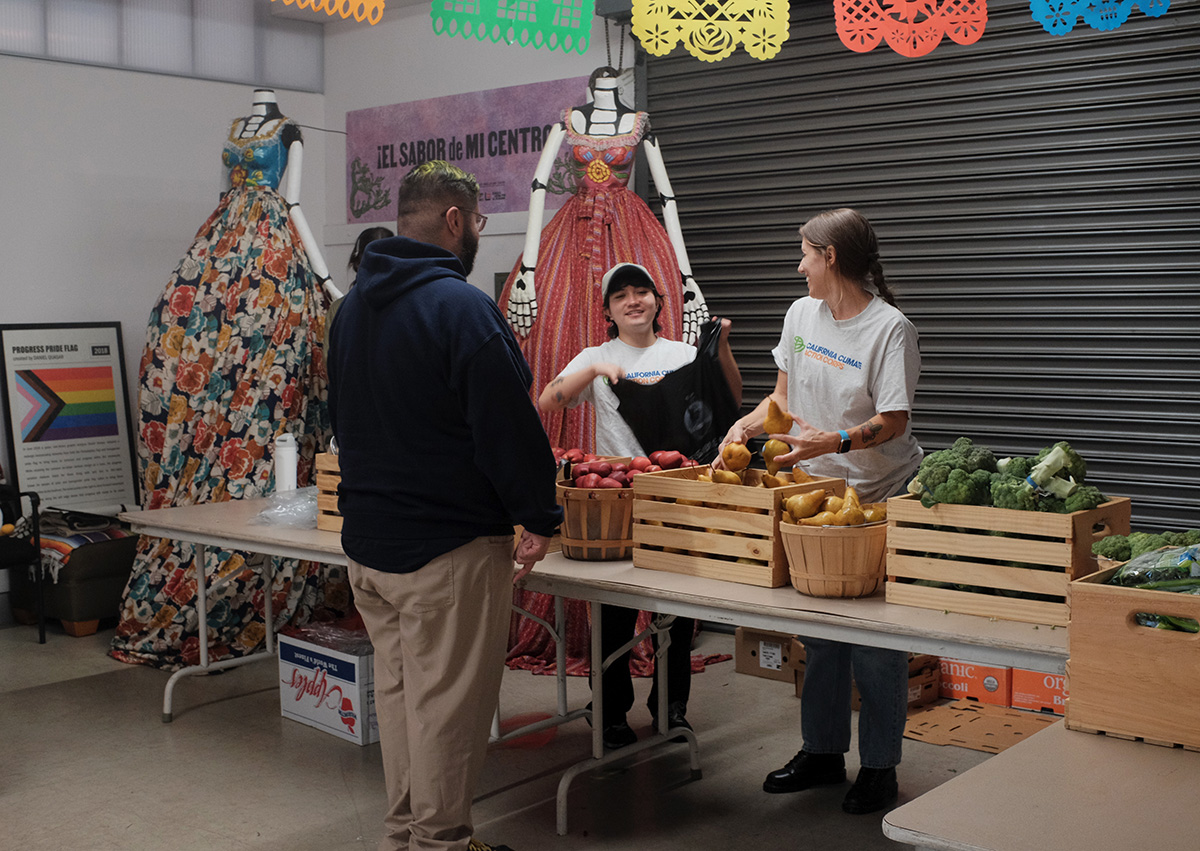
Light rain and mist loomed over the quiet Boyle Heights Neighborhood on Friday morning as residents made their way towards a free farmer’s market at Mi Centro, a community center on South Clarence Street. There, they were greeted with a warm“buenos días” by program coordinator Norma Sánchez and guided into an adjacent room with crates of fresh produce and a table with mental health resources.
Created in collaboration with team members from both the Los Angeles LGBT Center and the Latino Equality Alliance, Mi Centro doubles as a hub for information and resources as well as a sanctuary of respite and comfort for its Latine community members. It provides immigration services, legal clinics, housing rights panels, and a monthly free farmers’ market. This November, Mi Centro has organized an additional market with the support of collaborating organizations, including food justice ministry Seeds of Hope, to step up for community members after SNAP benefits were cut at the beginning of the month.
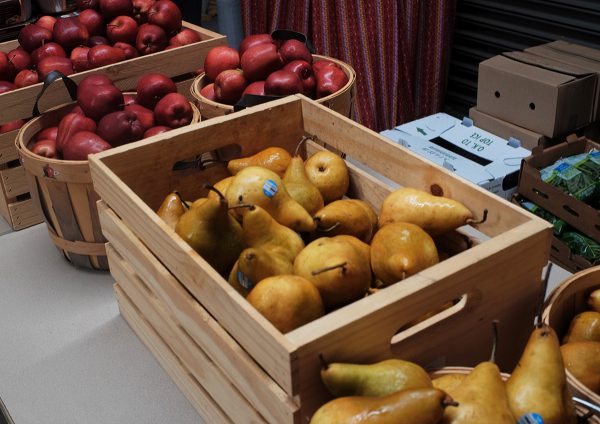
Combined with the increased presence of federal immigration agents in the county since June, this cut in essential funding has created additional strain for local Latine community members when it comes to accessing food and feeling safe when stepping outside. For staff members at Mi Centro, these issues impact the livelihoods and safety of the people and spaces most familiar and important to them. “This is the community where my family immigrated to,” Caín Andrade, Mi Centro’s program manager, told the Blade. “Now I feel like it’s not only my duty, but my pleasure and my privilege to come back to the same community and help.”
At Friday’s market, Andrade noted that it yielded one of the “biggest turnouts” despite the weather, and explained that Mi Centro has seen a steady increase in the need for food and resource assistance in the last couple of months. Several community members showed up to access groceries and look through the other resource tables at the market. One of these tables included information about benefits and insurance enrollment, and another included pamphlets from local health nonprofit QueensCare about free health screenings. All written materials were provided in both Spanish and English, and Sánchez made sure to speak with each resident about their needs.
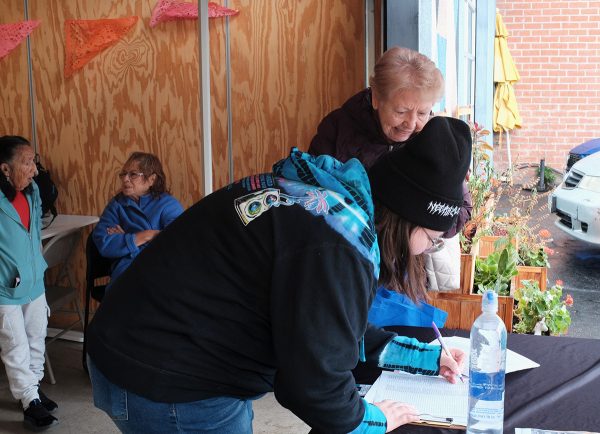
“We really curated Mi Centro as a community center where people can feel like they belong,” said Andrade. “[We] provide a space that feels a little bit more like home to them: that’s warm, that’s got flowers and art, a couch to sit on, and just have somebody that listens to you — somebody that can speak Spanish and give them the opportunity to articulate what they’re going through in their language. We can see the sighs of relief.”
Andrade also emphasizes the intergenerational teamwork that happens at Mi Centro: a synergy that is guided by “young, queer Latino community” voices that have been embedded within the neighborhood. Mi Centro’s queer staff are deeply shaped by these communities that have long been home to them — and they, in turn, are shaping these spaces to be more inclusive: where LGBTQ+ visibility is embraced and cherished.
With a team that “represents the entire rainbow,” residents see the advocates working to support them as “our kids, our nephews, our grandkids,” Andrade said. “We are equally protective of them. We want to make sure that they are being given access to everything that other communities might have easy access to.”
Mi Centro’s next free farmer’s market takes place on Friday, Nov. 21st. More information can be found here.
West Hollywood
West Hollywood invests $1 million to build LGBTQ+ Olympic hospitality house
Pride House LA/WeHo will be an interactive space for queer athletes and allies to celebrate the 2028 Summer Games together.
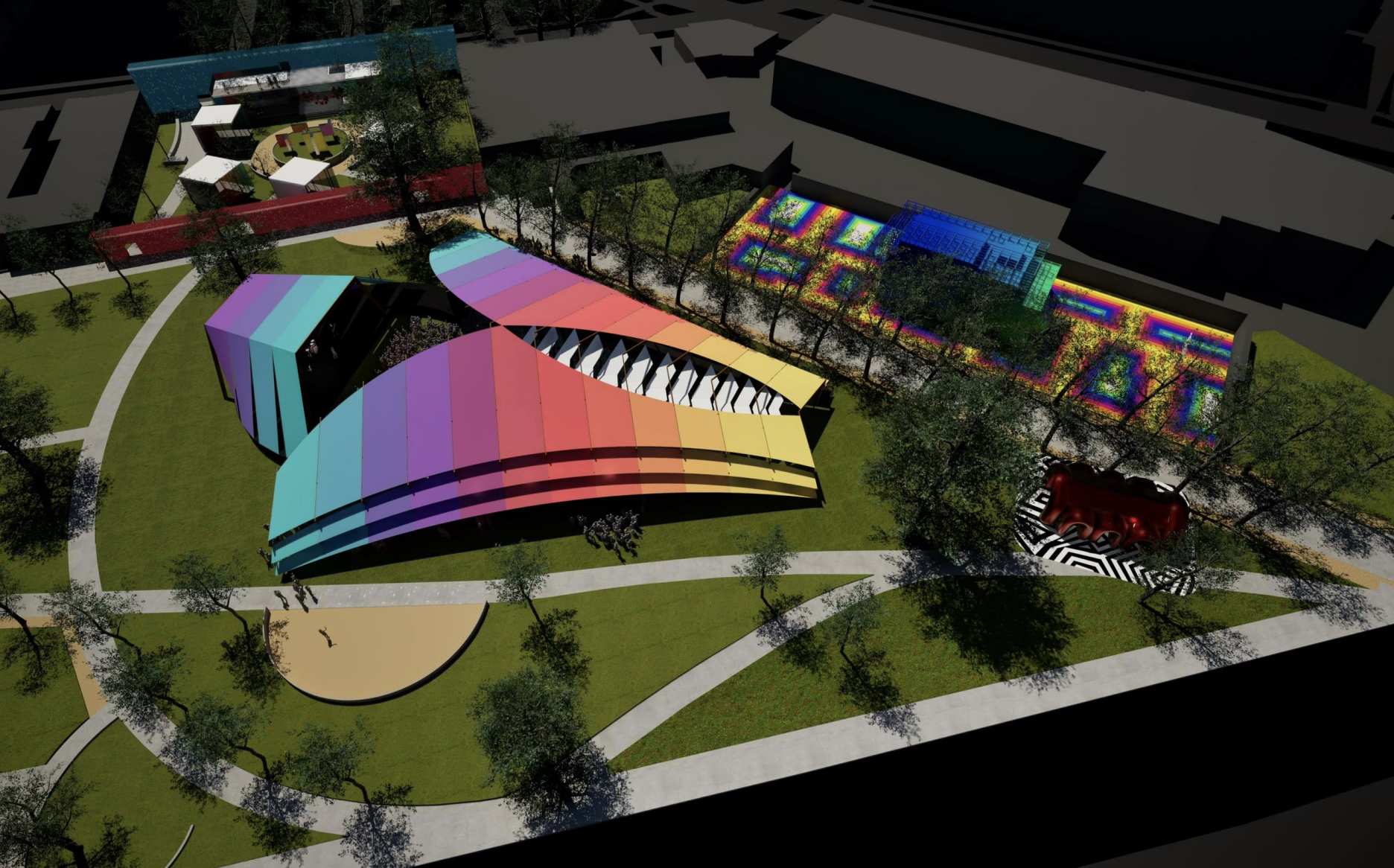
The first-ever Olympic hospitality house began with humble roots in 1992: a tent pitched on the Port of Barcelona for athletes to gather with their families. Since then, they transformed into fixtures of several major sporting events, with hopes of fostering belonging and safety for athletes of various cultural backgrounds.
It wasn’t until 2010 that the first LGBTQ+ hospitality house, the Pride House, appeared during the Winter Olympics in Vancouver. Over the years, its existence and visibility have faced barriers. During the 2014 Sochi Winter Olympic Games in Russia, Pride House International was denied from organizing its safe hub. The rejection was a blow to the visibility and safety that the organization was trying to promote and create for queer athletes. But this didn’t go unnoticed. International fans demonstrated quiet resistance, hosting remote Pride Houses in support of the Olympians who were barred from openly communing and celebrating together.
As Los Angeles prepares to host the Summer Olympics in July 2028, Pride House is coming back stronger than ever. In early October, the West Hollywood city council approved an agreement that would allocate $1 million to sponsor Pride House LA/WeHo as they prepare to build a temporary structure at West Hollywood Park for the 2028 Games. For 17 days, vibrant LGBTQ+ sports programming will fill the park’s grassy knolls.
Pride House LA/WeHo CEO Michael Ferrera detailed at a Nov. 1st Out Athlete Fund fundraising event that the team plans to build a concert stage to seat over 6,000 people. There will also be a museum that will take viewers through 100 years of queer Olympics history, viewing areas for people to watch the games, and a private athlete village for queer Olympians. “The dream of that is — imagine you’re an athlete from a country where you can’t be out,” said Ferrera. “You come here, and you can be safe and sound.”
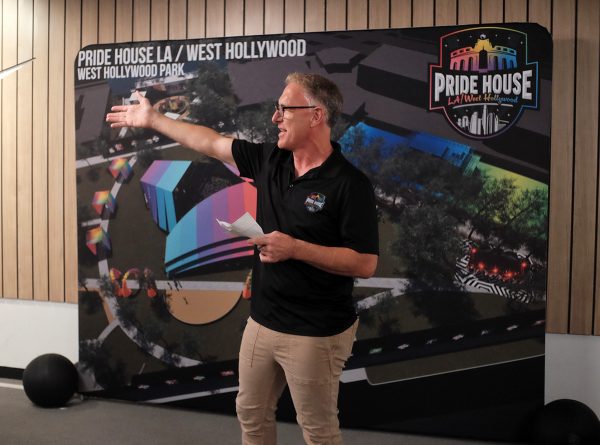
As outlined in the city council agreement and stated by Ferrera, most of the programming will be free and open to the public, and in the heart of a neighborhood that many of the county’s queer residents recognize as their safe haven. “We’re centering this important event in West Hollywood Park where our community has come together for decades in celebration, in protest, to support each other and to live our lives,” Pride House LA/WeHo CEO Michael Ferrera wrote to the Blade. “There is no place that is more representative of inclusion and safe spaces.”
The City of West Hollywood is promoting this inclusion further by asking for local community members to voice their perspectives on the formation of Pride House LA/WeHo at West Hollywood Park. On Monday, a community conversation will take place at Plummer Park to encourage residents to help shape the cultural programming that will take place in the summer of 2028. Another conversation will take place on Nov. 21st at the City’s 40th anniversary of Cityhood event.
“We couldn’t do this without the generosity and partnership of the city of West Hollywood,” Pride House LA/WeHo marketing co-lead Haley Caruso wrote to the Blade. “We are so happy to help bring the Olympic spirit to West Hollywood while also providing the community a safe and entertaining venue to enjoy the Games.”
Head to PrideHouseLAWeho.org for more information
Los Angeles
LA Assessor Jeffrey Prang to be honored by Stonewall Democrats
Prang is among America’s longest-serving openly gay elected officials
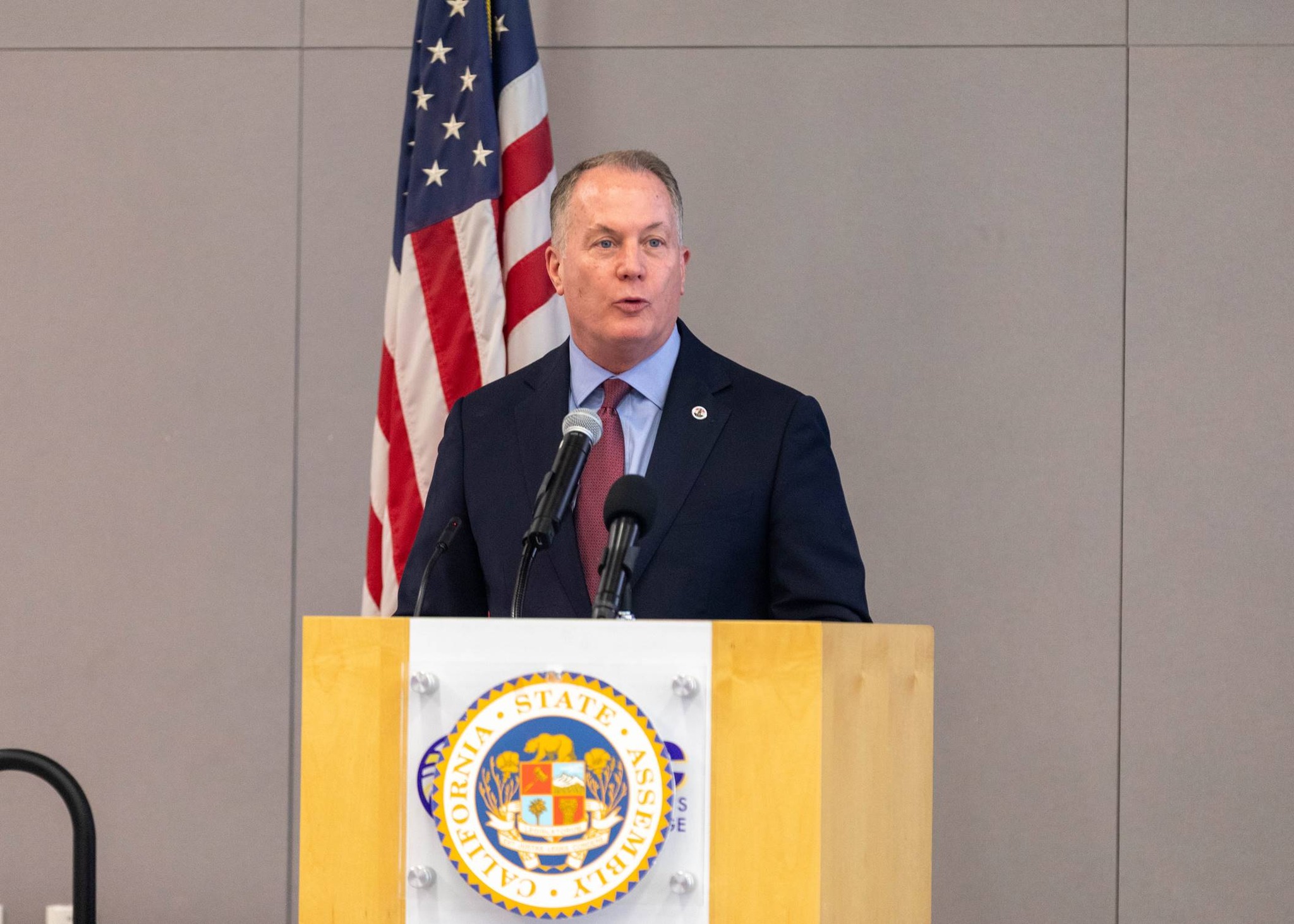
You may not be too familiar with LA County Assessor Jeffrey Prang. You’ve probably never heard of the office of the LA County Assessor, or you might only have a vague notion of what it does.
But with a career in city politics spanning nearly thirty years, he’s among the longest-serving openly gay elected officials in the United States, and for his work serving the people of Los Angeles and championing the rights of the city’s LGBTQ people, the Stonewall Democratic Club is honoring him at their 50th Anniversary Celebration and Awards Night Nov 15 at Beaches Tropicana in West Hollywood.
Prang moved to Los Angeles from his native Michigan after college in 1991, specifically seeking an opportunity to serve in politics as an openly gay man. In 1997, he was elected to the West Hollywood City Council, where he served for 18 years, including four stints as mayor.
“I was active in politics, but in Michigan at the time I left, you couldn’t really be out and involved in politics… My life was so compartmentalized. I had my straight friends, my gay friends, my political friends, and I couldn’t really mix and match those things,” he says.
“One of the things that was really impactful was as you drove down Santa Monica Boulevard and saw those rainbow flags placed there by the government in the median island. That really said, this is a place where you can be yourself. You don’t have to be afraid.”
One thing that’s changed over Prang’s time in office is West Hollywood’s uniqueness as a place of safety for the queer community.
“It used to be, you could only be out and gay and politically involved if you were from Silver Lake or from West Hollywood. The thought of being able to do that in Downey or Monterey Park or Pomona was foreign. But now we have LGBTQ centers, gay pride celebrations, and LGBT elected officials in all those jurisdictions, something that we wouldn’t have thought possible 40 years ago,” he says.
Prang’s jump to county politics is emblematic of that shift. In 2014, amid a scandal that brought down the previous county assessor, Prang threw his name in contention for the job, having worked in the assessor’s office already for the previous two years. He beat out eleven contenders in the election, won reelection in 2018 and 2022, and is seeking a fourth term next year.
To put those victories in perspective, at the time of his first election, Prang represented more people than any other openly gay elected official in the world.
Beyond his office, Prang has lent his experience with ballot box success to helping get more LGBT people elected through his work with the Stonewall Democrats and with a new organization he co-founded last year called the LA County LGBTQ Elected Officials Association (LACLEO).
LACLEO counts more than fifty members, including officials from all parts of the county, municipal and state legislators, and members of school boards, water boards, and city clerks.
“I assembled this group to collectively use our elected strength and influence to help impact policy in Sacramento and in Washington, DC, to take advantage of these elected leaders who have a bigger voice in government than the average person, and to train them and educate them to be better advocates on behalf of the issues that are important for us,” Prang says.
“I do believe as a senior high-level official I need to play a role and have an important voice in supporting our community,” he says.
Ok, but what is the LA County assessor, anyway?
“Nobody knows what the assessor is. 99% of people think I’m the guy who collects taxes,” Prang says.
The assessor makes sure that all properties in the county are properly recorded and fairly assessed so that taxes can be levied correctly. It’s a wonky job, but one that has a big impact on how the city raises money for programs.
And that wonkiness suits Prang just fine. While the job may seem unglamorous, he gleefully boasts about his work overhauling the office’s technology to improve customer service and efficiency, which he says is proving to be a role model for other county offices.
“I inherited this 1970s-era mainframe green screen DOS-based legacy system. And believe it or not, that’s the standard technology for most large government agencies. That’s why the DMV sucks. That’s why the tax collection system sucks. But I spent $130 million over almost 10 years to rebuild our system to a digitized cloud-based system,” Prang says.
“I think the fact that my program was so successful did give some impetus to the board funding the tax collector and the auditor-controller to update their system, which is 40 years behind where they need to be.”
More tangible impacts for everyday Angelenos include his outreach to promote tax savings programs for homeowners, seniors, and nonprofits, and a new college training program that gives students a pipeline to good jobs in the county.
As attacks on the queer community intensify from the federal government, Prang says the Stonewall Democrats are an important locus of organization and resistance, and he encourages anyone to get involved.
“It is still an important and relevant organization that provides opportunities for LGBTQ people to get involved, to have an impact on our government and our civic life. If you just wanna come and volunteer and donate your time, it provides that, if you really want to do more and have a bigger voice and move into areas of leadership, it provides an opportunity for that as well,” he says.
Los Angeles
SNAP benefits remain delayed — local leaders are creating their own solutions
Assemblymember Mark González has announced a $7.5 million partnership with the YMCA’s FeedLA food distribution program.
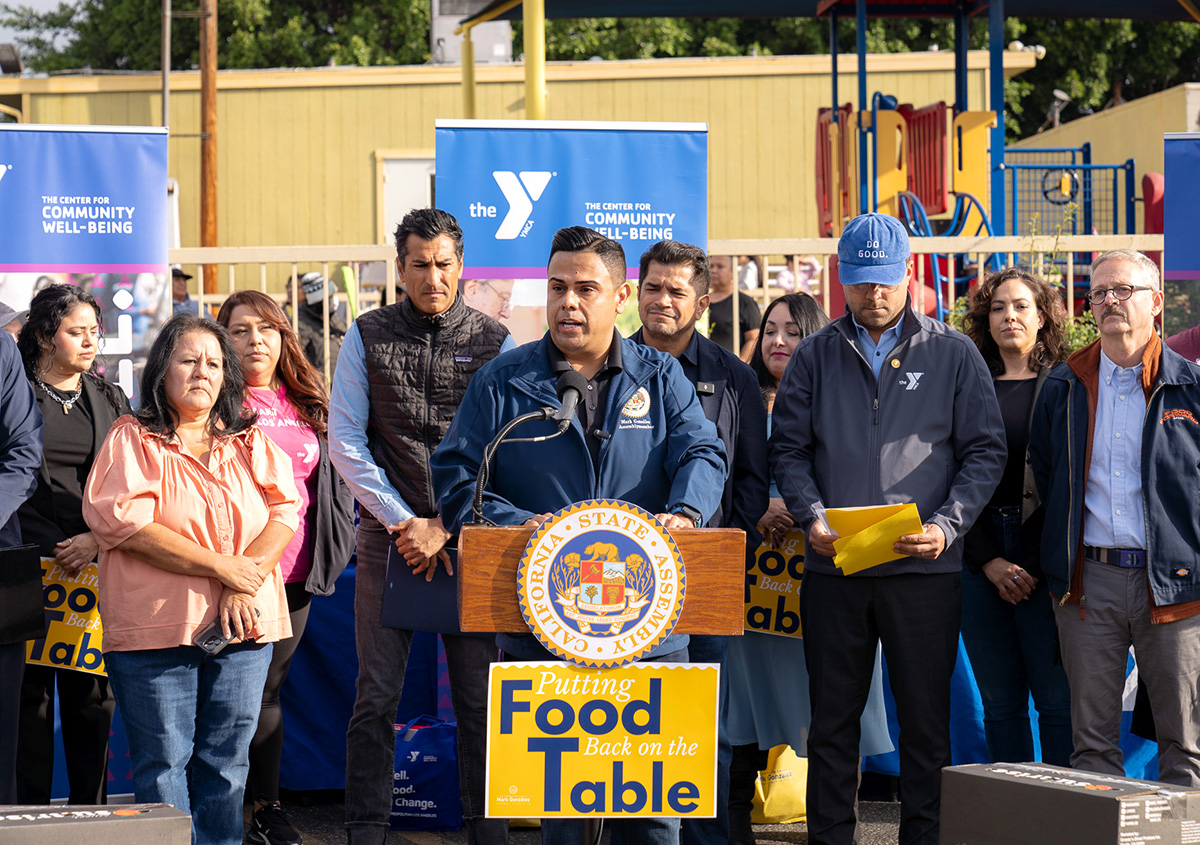
Today marks the 37th day of the current government shutdown, the longest witnessed in the country’s history. As a result, people who receive federal Supplemental Nutrition Assistance Program (SNAP) benefits have not received their monthly aid for November. In Los Angeles, over 1.5 million people rely on these funds to purchase groceries.
On Oct. 28th, Governor Gavin Newsom announced that California joined over 20 other states in suing the administration over its “unlawful refusal” to provide SNAP aid even though it has the funds to do so. Two federal judges ruled in favor of the lawsuit, though when and how much aid will be distributed remains inconclusive.
At a press briefing on Tuesday, White House press secretary Karoline Leavitt stated that the administration is “fully complying” with the court order. “The recipients of the SNAP benefits need to understand: it’s going to take some time to receive this money because the Democrats have forced the administration into a very untenable position,” Leavitt continued. “We are digging into a contingency fund that is supposed to be for emergencies, catastrophes, for war.”
On Wednesday morning, local leaders in Los Angeles held their own press conference at the Weingart East Los Angeles YMCA to denounce the administration’s inaction and to discuss alternative efforts that are trying to fill the gap as SNAP aid remains suspended. “We’re here today because the federal government has turned its back on millions of families, and we refuse to stay silent,” said District 54 Assemblymember Mark González. “This is more than a press conference. This is a plea for sanity, a demand for humanity, and a call to action…California is stepping up to do what Washington will not, and that’s to feed our people.”
Alongside a number of other local leaders and advocates, including Assemblymember Jesse Gabriel, Speaker of the California State Assembly Robert Rivas, Boyle Heights community leader Margarita “Mago” Amador, Congressman Jimmy Gomez, YMCA president Victor Dominguez, and Food Forward founder Rick Nahmias, González announced a partnership with the YMCA’s FeedLA program. $7.5 million has been secured to fund food distribution efforts across the county’s 29 YMCA sites.
Residents do not need to have a YMCA membership to take part. Resources like groceries, warm meals, and home deliveries will be available at various times throughout the week. There are currently no weekend distribution dates listed.
This announcement comes in the midst of other local efforts bolstering on-the-ground SNAP relief. On Tuesday, the Los Angeles County Board of Supervisors approved a motion that will strengthen the Office of Food Systems (OFS), a partnership between county leaders and local philanthropic organizations aiming to create equitable food systems for residents. The motion would establish deeper connections between OFS and all County departments, as well as strengthen state and federal food policy coordination.
The county has also funded a $10 million contract with the Los Angeles Regional Food Bank, which will allow the organization to purchase more produce and create additional pantry and food distribution pop-up sites.
For many, these solutions offer a temporary landing pad as they hold out for their benefits to be reinstated. “Food pantries are not just places where a bag of food is handed out. They are a bridge of hope for our most vulnerable communities,” said Amador, at Wednesday’s press conference. “When a family comes to a pantry, many times they don’t just bring an empty bag. They also bring worries, stress and [the] fear of not being able to feed their children. They leave with a bag of food [and] they take with them a bit of dignity, relief, and a feeling that they are not alone.”
California
Prop 50 has passed, with overwhelming support from local voters and LGBTQ+ advocates
Over 5 million Californians voted in support of the congressional redistricting measure.
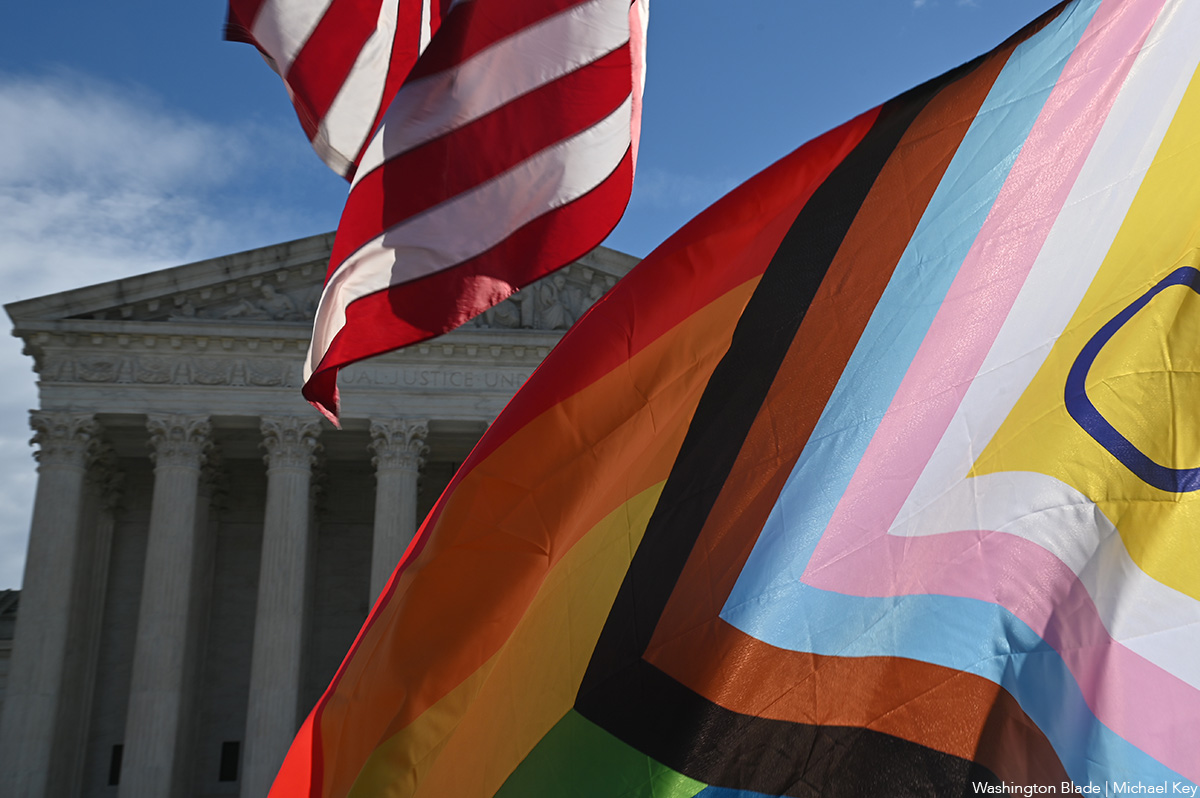
Yesterday, on the night of the California statewide special election, polls closed at 8 pm for the vote on Proposition 50, the “Election Rigging Response Act.” The measure was created to combat Texas lawmakers’ plans to redraw their state’s congressional districts ahead of the November 3rd, 2026, midterm elections in order to secure more Republican seats in Congress.
A “yes” vote on Prop 50 would allow California to temporarily redraw its own congressional district maps beginning in 2026, according to the California Voter Information Guide. Since August, Democratic organizers and leaders have been advocating for the passage of the measure as a way to stand up to “cheating” that has been committed by other states.
Last night, over 8 million ballots were counted, and an overwhelming 63.8% of these were votes in favor of Prop 50. In Los Angeles County alone, nearly 2 million ballots were submitted, and 73% of voters sided with passing the measure.
Governor Gavin Newsom celebrated the victory as an act of resistance. “Instead of agonizing over the state of our nation, we organized in an unprecedented way,” he said, in a series of video statements posted online. “We stood tall and we stood firm in response to Donald Trump’s recklessness. And tonight, after poking the bear, this bear roared — with an unprecedented turnout in a special election with an extraordinary result.”
The results have also fueled impassioned LGBTQ+ leaders to keep the fight going, especially as federal legislation continues to put queer and trans communities at risk. “Donald Trump and MAGA Republicans have systematically targeted LGBTQ+ rights, rolling back nondiscrimination protections, erasing our history, and attacking transgender kids and their families,” said Tony Hoang, director of LGBTQ+ civil rights organization Equality California, in a press release. “With the passage of Proposition 50, Californians have sent a clear message: our votes will not be silenced, our voices will not be ignored, and our rights will not be rolled back during a rigged midterm election.”
Advocates have also stressed that Prop 50 sets a precedent in creating more ground in the ongoing battle for increased rights and protections for queer communities. “Tonight’s victory is critical in the fight to secure a pro-equality majority in Congress,” said Kelley Robinson, president of the Human Rights Campaign, another notable LGBTQ+ civil rights group. “This is a victory powered by communities that refuse to be silenced and are unwavering in their commitment to defending democracy.”
-

 Los Angeles8 hours ago
Los Angeles8 hours agoLGBTQ+ community calls out Radio Korea over host’s homophobic comments; station acknowledges but skirts accountability
-
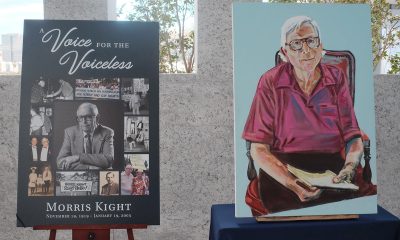
 Los Angeles1 day ago
Los Angeles1 day agoForgetting queer pioneer Morris Kight is “impossible”: Advocates and friends share stories at remembrance
-

 Movies1 day ago
Movies1 day agoEven Ariana Grande and Cynthia Erivo can’t save the fractured and messy ‘Wicked: For Good’: Film Review
-
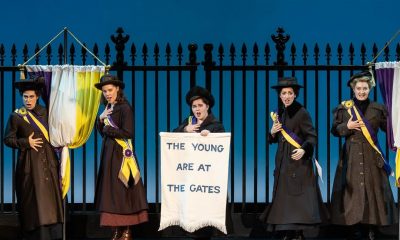
 a&e features4 days ago
a&e features4 days ago‘Suffs’ star Gwynne Wood wants us to continue to find hope
-
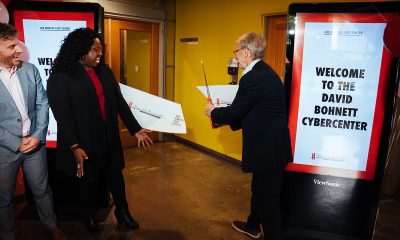
 Los Angeles4 days ago
Los Angeles4 days agoThe Los Angeles LGBT Center has reopened and upgraded its community tech hub
-

 Movies4 days ago
Movies4 days agoTheater classic gets sapphic twist in provocative ‘Hedda’
-

 COMMENTARY3 days ago
COMMENTARY3 days agoDating during the holidays: Why cuffing season hits GBTQ men so hard
-

 Commentary4 days ago
Commentary4 days agoThe cost of competing: Olympic hopeful faces suspension for making ends meet with OnlyFans
-

 Autos2 days ago
Autos2 days agoRevving up the holidays with auto-themed gifts
-

 Commentary5 hours ago
Commentary5 hours agoBubba Trump: the Prez and the infamous files
